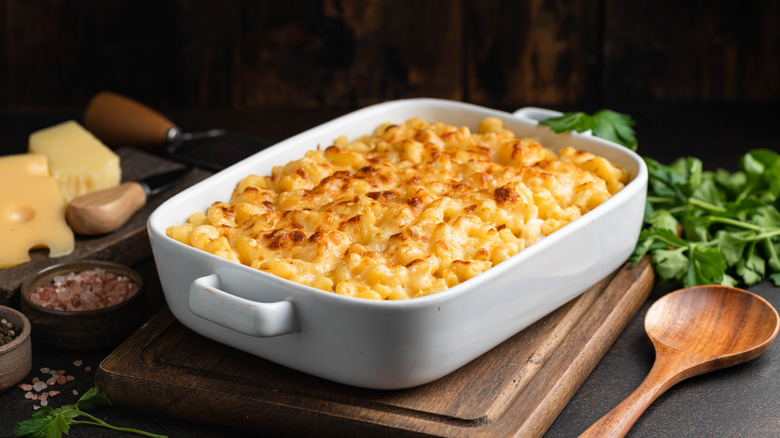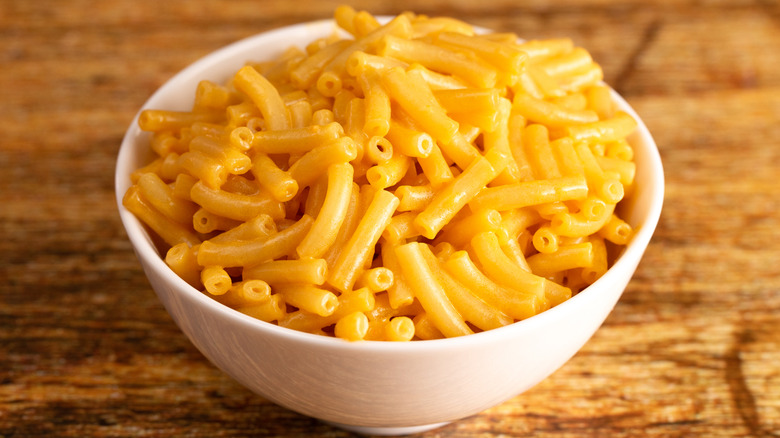A Cheesy History: How Mac And Cheese Was Invented
We may receive a commission on purchases made from links.
Cheesy and easy, few dishes feel more American than macaroni and cheese. But the story of this comfort food starts long before the boxed dinners and bubbling casserole dishes you may know from your grandma's kitchen, and, in fact, far from the United States. According to Epicurious, the earliest echoes of cheesy pasta date to 160 B.C., when Roman senator Marcus Porcius Cato wrote (in passing) about a layered baked dish including cheese and an ancient pasta dough called "placenta." By the Middle Ages, pasta-and-cheese pairings cropped up across Europe. Italian cookbooks like "Liber de Coquina" had recipes for what we would consider lasagna. Keep in mind this ancient lasagna didn't have tomato sauce, as tomatoes were brought over from the Americas in the 16th century. Instead, it featured two-inch squares of pasta that were layered and baked with a type of raw cheese – a rustic and simple form of macaroni and cheese, but pasta and cheese nonetheless.
By the 14th century, a famous English cookbook, "The Forme of Cury: A Roll of Ancient English Cookery Compiled," by the palace chefs of King Richard II, detailed a recipe for makerouns, which was essentially boiled macaroni topped with melted butter and grated cheese. Renaissance chefs later refined the formula — Maestro Martino authored a recipe for Roman macaroni, which included parmesan, butter, but also sugar and cinnamon, transforming it into a staple of aristocrats and edging it somewhat closer to the mac and cheese we know today. By the 18th century, macaroni and cheese, creamy, buttery, and savory, was a symbol of cosmopolitan dining in England and France. It was this French recipe, following centuries of evolution, that was then mastered by American chef James Hemings.
How mac and cheese reached American shores
James Hemings was a pioneering chef who cooked in the kitchen of one of America's first presidents. A Black man enslaved by Thomas Jefferson (who also happened to be the half-brother of Jefferson's wife), Hemings was taken to Paris when Jefferson served as U.S. ambassador. There, Hemings apprenticed with French chefs and mastered elite cooking techniques– including a version of macaroni and cheese built on béchamel and Gruyère. When Hemings returned with Jefferson to Monticello, he brought the dish stateside. Though Jefferson often receives the credit, it was Hemings's skill that gave mac and cheese its first true foothold in the United States.
From there, mac and cheese evolved from a delicacy of the elite into a household favorite. Black families, especially in the American South, became its guardians, carrying the recipe into generations of family tables, modified and changed to suit tastes and occasions. Sunday dinners became the time for the most traditional mac and cheese recipe, combining noodles with a creamy béchamel, topped with a layer of breadcrumbs that toasts to a golden crunch in the oven. But a simpler mac and cheese, made by stirring in cheese and milk into pasta over the stove, was often served up on weekdays.
The innovation of boxed mac and cheese
By the 20th century, industrialization took the beloved mac and cheese to even higher levels of convenience and popularity. Enter Kraft: In 1937, the company debuted its boxed mac and cheese, selling nine million boxes that year alone. With its prepackaged powdered cheese, the easy, affordable meal became a pantry staple during World War II rationing, and its popularity only grew from there. The recipe has changed a bit through the years– in 2015, Kraft removed all artificial colorings and preservatives, but the comfort-food taste remained the same. By 2022, Kraft was selling over a million boxes a day across the USA. Today, Kraft's iconic blue box still reigns, but our taste test of boxed mac and cheese suggests Cracker Barrel Sharp Cheddar may be the richer, creamier choice.
Regardless of which brand you choose, a boxed mac and cheese is, by now, a time-honored classic. And there's no need for it to be boring — boxed mac and cheese can be easily elevated with add-ins. Try folding in caramelized onions, swapping in sharp cheddar for an extra kick, or stirring in Buffalo chicken for a game-day twist. But do watch out for some mac and cheese add-ins that really cross the line. Crayon-colored food dyes or shredded cheese can push the dish into unappetizing territory. If it ain't broke, don't fix it — mac and cheese should be creamy, comforting, and familiar.



